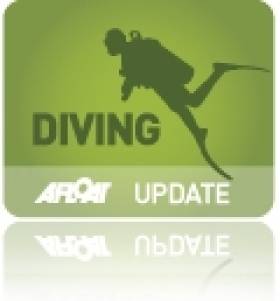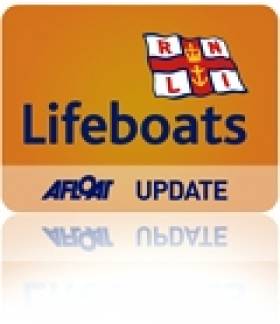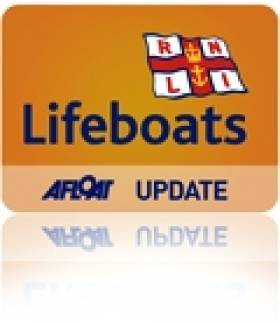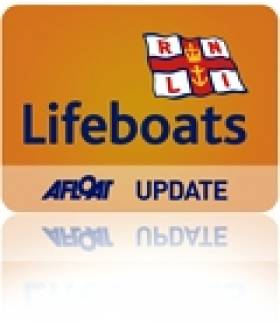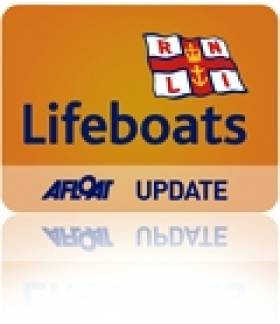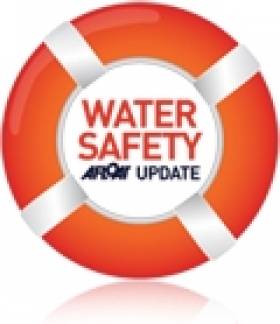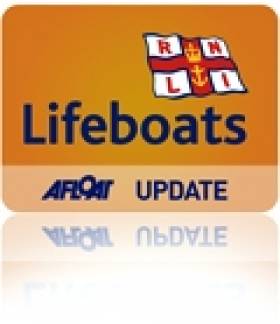Displaying items by tag: RNLI
British And NI Divers Called To Take Part In RNLI Survey
#Diving - Divers across Britain and Northern Ireland are being called on to help the RNLI with research into participation and attitudes to safety in the sport by taking part in a new online survey.
The RNLI, in partnership with the British Diving Safety Group (BDSG), is asking divers and dive instructors in the UK to take 10 minutes to complete the online survey, which looks at their reasons for participating in diving, how often they take to the water, preferred methods and locations, experience and training, awareness of possible hazards and use of safety measures.
The findings will be used to help the RNLI and BDSG develop tailored and relevant safety messages for the diving community, to help make the sport even safer.
Last year alone, 314 diving incidents were reported to the British Sub-Aqua Club (BSAC). The survey, being undertaken by Substance on behalf of the RNLI, launched on Tuesday 27 August and will run for nine weeks, during which time anyone who dives in the UK – no matter how often or what level of experience – is invited to take part.
To supplement the online survey, face-to-face surveys will be conducted at dive sites, charter boat launch and departure points, and at Dive 2013, the NEC Dive Show in October. In-depth interviews and focus groups will also be conducted. Divers wishing to take part in these are encouraged to contact Substance via the survey website.
RNLI coastal safety manager Nick Fecher, who is running the project, explained the reasoning behind the research.
"Diving is a hugely popular sport but accidents do happen. A total of 314 diving incidents were reported to BSAC last year and the RNLI’s volunteer lifeboat crews have rescued 96 divers and saved 13 divers’ lives in the past five years," he said.
"By carrying out this research, we hope to understand more about how and why people dive, what they know about the risks and what safety measures they take. We’re hoping to hear from divers of all levels of experience, so we can then develop really targeted and relevant safety advice to help them enjoy their sport as safely as possible.
"Coastal safety is a key part of the RNLI’s remit of saving lives at sea – by offering important safety advice to people taking part in coastal activities like diving, we hope to prevent incidents from happening in the first place and, ultimately, save lives."
All who participate in the survey are offered the option of free entry into a prize draw, with the first prize of a DX dive computer, kindly donated by Suunto Diving UK, and a second prize of an Abyss 22 regulator, kindly donated by Mares. Winners will be chosen by Substance using a random number generator by 15 November.
Courtmacsherry RNLI Volunteer Assists Call-Out Off English Coast
#RNLI - A volunteer crew member from Courtmacsherry RNLI found himself involved in a lifeboat call out miles from home this week when he went to the assistance of yacht involved in a collision off Cumbria yesterday (29 August).
Barrow RNLI launched their all-weather lifeboat when Liverpool Coastguard requested assistance following a report of a collision between a 28ft yacht, Shola, and a large vessel some 13 miles off Walney Island in Morecambe Bay.
Also making his way to the scene was Kevin Young, skipper of the Windcat 6 with two crew, who was 3.5 miles from the incident when the call for assistance was received.
It was unknown if there was any damage caused to either vessel, but the yacht skipper - a lone sailor - was believed to be suffering from shock.
Once on scene, Young transferred one of his crew aboard the casualty yacht to take command and took off the yachtsman, who was showing signs of shock. They then made their way at speed to Barrow-in-Furness where they met the Barrow lifeboat, which then took over the casualty care.
Liverpool Coastguard had also requested the attendance of a rescue helicopter from RAF Valley, and upon its arrival the casualty was airlifted from the lifeboat onto the aircraft and transferred to Furness General Hospital for assessment.
An RNLI crew member from Barrow was then put aboard the yacht with the crewman from Windcat 6 and the vessel was sailed to Roa Island, where it was assisted to moor up on a casualty mooring by the inshore lifeboat.
"The last thing I thought I would be doing at my day job would be getting involved in a call-out with the RNLI but that’s exactly what happened," said Young, who works with wind farms off the English coast but serves as a member of the volunteer lifeboat crew when home in Courtmacsherry.
"When I spoke to the lifeboat crew they seemed surprised that I was able to brief them exactly on what we had done and how we had everything ready to hand over to them, so I explained to them that I was a deputy coxswain back home on our all-weather Trent class lifeboat and they understood.
"This callout shows that you never forget your training and the desire to help those in trouble on the sea," he added. "The skipper of the yacht was clearly in shock and needed assistance and thankfully with all the agencies working together we were able to get him medical attention and transferred to hospital quickly and safely.
"It’s good to know that RNLI lifeboat volunteers are the same wherever you go."
Wicklow Lifeboat Aids Troubled Motor Boat
#RNLI - Wicklow RNLI launched its all-weather lifeboat Annie Blaker shortly before 5pm yesterday (29 August) to assist two crew on a small motor boat with engine problems.
The lifeboat was requested to launch by the Irish Coast Guard following a report that a small boat was drifting south of Wicklow Harbour and the occupants appeared to be having difficulties starting the engine.
Speaking after the call-out, Wicklow RNLI press officer Tommy Dover said: "The boat owner succeeded in restarting the engine so the lifeboat escorted the boat with two people safely into Wicklow harbour."
The crew on the callout were coxswain Nick Keogh, mechanic Brendan Copeland and crew members Brian Sinnott, Connie O'Gara, John Vize, Dean Mulvihill and Graham Fitzgerald.
Achill Island Lifeboat Attends Injured Woman Off Mayo Cliffs
#RNLI - Achill Island RNLI was tasked to assist a young woman in distress off the cliffs of Old Head in Louisburgh, Co Mayo yesterday afternoon (28 August).
The volunteer lifeboat crew sped to the scene around 4pm yesterday after the woman, who had been diving from a cliff into the sea, was injured on entering the water and required urgent assistance.
As the lifeboat was en route, some of the woman’s friends managed to pull her from the water onto nearby rocks, below the cliff, to await help.
The lifeboat arrived shortly after and sent two crewmen ashore to administer first aid. Westport Coast Guard Unit and Rescue 115, the helicopter from Shannon, were also tasked to the scene.
The woman was taken on board the lifeboat and transferred to the helicopter, which took her to Castlebar General Hospital where her injuries were treated.
Lifeboat operations manager Tom Honeyman said: “This had been a very busy but fulfilling year for the volunteer lifeboat crew with this, the 20th shout so far in 2013.
"It is also another good example of the different wings of the emergency services working in tandem to affect a successful outcome.”
Skerries RNLI Atlantic 85 Lifeboat to be Named
#rnli – A new Atlantic 85 lifeboat for Skerries RNLI is to be officially named Louis Simson during a ceremony at the lifeboat station in the north county Dublin coastal town at 2pm on Saturday 7 September. The lifeboat which went on service in February was funded by a 75-year-old legacy from the late Charlotte Jordan Simson in memory of her husband Louis.
Charlotte who hailed from Salem, India, married Louis Simson, a native of London, in 1882. The couple relocated to Tasmania where Louis was a mining agent and stockbroker. Following his death in 1922, Mrs Simson returned to the UK where she lived in Paddington London until her death in September 1938. Mrs Simson made provision in her will for a trust fund that would provide various relatives with a modest income for life. She arranged that, once the trust fund had come to an end, the remaining money should fund an RNLI lifeboat to be named in memory of her beloved husband.
Now, three quarters of a century on, Mrs Simson's wish will be granted when Leo Cody, a former Deputy Launching Authority and one of the founding members of Skerries RNLI station, will officially name the lifeboat.
Niall McGrotty, Skerries RNLI Lifeboat Operations Manager said: 'This is a very special occasion for our lifeboat station and we are most grateful to the late Charlotte Simson for her generous legacy which has funded our lifeboat, Louis Simson. Since the lifeboat went on service earlier this year, there have been 21 call outs and 45 people have been brought to safety. We will be proud custodians of this lifeboat, which will go on to rescue and save many more lives in the years ahead'.
The RNLI established a lifeboat station in Skerries in 1854 and a boathouse was built. The station closed in 1930 when a motor lifeboat was placed on service at Howth. The station was re-established as an inshore lifeboat station with a D class lifeboat in 1981. The lifeboat was kept in a stone-built house on the sea front.
In 1997, a B class Atlantic 21 lifeboat was placed at the station for evaluation and a new boathouse was completed in August that year for the Atlantic lifeboat and launching tractor.
The Atlantic 75, B-747 Rockabill, named after a lighthouse off Skerries, was place on service in June 1998.
In 2005, the station was awarded a Centenary Vellum to commemorate an aggregate of 100 years service as a lifeboat station.
Fast, manoeuvrable and reliable, the B class operates in rough weather conditions, capable in daylight up to force seven and at night, to force six winds.
The new lifeboat, an Atlantic 85 is the latest version of the B class, introduced into the fleet in 2005. She is powered by two 115horsepower engines and has a stronger hull and greater top speed than her predecessor. The added radar allows the crew to operate more effectively in poor visibility and she also has VHF direction-finding equipment.
The vessel also has a manually operated self-righting mechanism which combined with inversion-proofed engines keep the lifeboat operational even after capsize. The lifeboat can also be beached in an emergency without causing damage to its engines or steering gear.
The Atlantic 85 carries a full suite of communication and electronic navigation aids, as well as a searchlight, night-vision equipment and flares for night-time operations.
Portaferry Lifeboat Attends Converted Trawler After Power Failure
#RNLI - Portaferry RNLI responded to a mayday call about a converted fishing trawler at Ringhaddy Sound in Strangford Lough on Saturday night (24 August).
The alarm was raised by the crew of a nearby yacht who reported two men and two women on board an 80ft converted trawler, which had lost all power and was taking on water.
The Portaferry lifeboat crew launched before 8pm and were on the scene within 15 minutes. The sea at the time was calm with no wind and good visibility.
When the lifeboat arrived, one man and one woman had already transferred to the neighbouring yacht. The lifeboat crew then requested a salvage pump to help pump the water from the stricken boat.
A local vessel from Portaferry lent assistance by taking a pump to the lifeboat crew, and they met halfway between Portaferry and Ringhaddy.
With the assistance of the crew of the yacht who had called in the alert, the lifeboat manoeuvred the converted trawler onto the pontoons at Ringhaddy, and remained while the last of the water was pumped out and all four of its compliment were safely ashore.
Portaferry RNLI volunteer lifeboat operations manager Brian Bailie said: "We would like to pass on our thanks to everyone who helped bring this mayday call to a safe conclusion.
"The prompt actions of everyone involved resulted in a positive outcome and the volunteer RNLI crew for the second time in as many days helped to avert a potentially very serious situation."
Meanwhile, Donaghadee RNLI also launched on Saturday to go to the aid of a 17ft powerboat with four men on board that had run out of fuel off the Copeland Islands.
Belfast Coastguard received a call from the men shortly after 5pm and requested the lifeboat to launch.
The all-weather lifeboat crew, under second coxswain John Ashwood, located the vessel quickly and the decision was made to tow the casualty back to Donaghadee harbour. All returned safely shortly after 5.45pm.
Wexford, Wicklow and Courtown Lifeboats Have A Busy Few Days
#RNLI - Wexford RNLI rescued two people late on Monday night (26 August) after their yacht went aground on a sandbank on the way into Wexford Harbour.
The volunteer lifeboat crew responded to the report of the yacht which had grounded near Ravens Point around midnight on Monday. Weather conditions at the time were good with a calm sea state and a north westerly force three wind.
But a fast-flowing tide of four knots meant that the inshore lifeboat and crew of the yacht had to work hard to refloat that boat.
Wexford RNLI lifeboat helm Peter Scallan commended the action of the yacht's crew, who he said were experienced sailors.
"The yacht's crew had taken all the correct precautions with the appropriate equipment on board to ensure their safety. They co-operated greatly with the lifeboat crew and as a result both they and their yacht were rescued."
Lifeboat crew member Alan Keville went onboard the vessel to assist in the manoeuvre to get the yacht off the sandbank, which involved using the mast to get the vessel on its side as the keel was stuck hard in the sandbank. The yacht was under tow at 1.14am and back in Wexford at 2.30am.
Elsewhere, the Courtown lifeboat launched on Sunday afternoon (25 August) to a report of a swimmer missing off Ardamine beach.
The lifeboat crew, who were in the harbour at the time, launched within minutes and commenced a search of the area. Irish Coast Guard helicopter Rescue 117 was also tasked to the scene, along with the Courtown coastguard unit.
After a thorough search of the area between Glasscarrig and Courtown pier, all rescue services were stood down as nothing was found. Courtown RNLI thanked all the members of public who helped and provided information during the call out.
The day before, the Wicklow RNLI inshore and all-weather lifeboats were launched after a member of the public reported seeing a small craft with two people drifting off Brittas Bay beach.
While the lifeboats were on route to Brittas Bay, they were requested to stand down and return to station by the coastguard as the boaters managed to make their own way ashore.
Speaking after the call-out, Wicklow RNLI lifeboat operations manager Des Davitt said: "While this turned out to be a false alarm with good intent, we are delighted that the public are being vigilant and contact the coastguard immediately when they suspect someone is in trouble on the water."
Video: RNLI Gives Top Help Tips For Kayakers
#WaterSafety - The RNLI has posted the above video outlining what kayakers can do to call for help if they get into difficulty on the water.
Taking a whistle along for the trip is one sensible idea, as is ensuring a means of longer-range communication such as a VHF radio or a mobile phone in a dry case.
Carrying a flare may also prove handy, and there's always that old standby if other water users are within earshot - shouting as loud as you can to attract attention.
Crosshaven Lifeboat Aids Angler at Sea
#rnli – A teenager became very unwell this evening whilst on an angling trip to the Ling Rocks on the south coast.
The skipper of the angling boat became concerned as her condition deteriorated and asked Valentia Coast Guard for assistance.
The volunteers of Crosshaven lifeboat were paged at 5.33 pm and were underway at 5.40pm. The crew of Vincent Fleming with Ian O'Keefe and Warren Forbes were on scene 20 minutes later and assesed the casualty whilst in communication with the lifeboat Doctor, Dr john Murphy.
It was decided to get the casualty ashore as quickly as possible and the lifeboat headed to Roberts Cove and was met by the lifeboat Doctor and the ambulance service.
After assesment the casualty was transferred to Hospital.
RNLI Releases Video of Shetland Helicopter Wreck Search
#helicrash – The RNLI has released video footage (above) and photographs of the Aith Lifeboat crew at the scene of Friday's helicopter wreckage off the West Coast of Shetland as Afloat.ie reported earlier
The lifeboat footage taken from onboard cameras shows the crew surveying the scene of the incident on Friday evening with lighting rigs erected on the mainland to assist rescuers.
A yellow flotation device can be seen in the images and this is part of the helicopter's safety equipment.
Four people were killed when the Super Puma helicopter came down south of Garths Ness.

